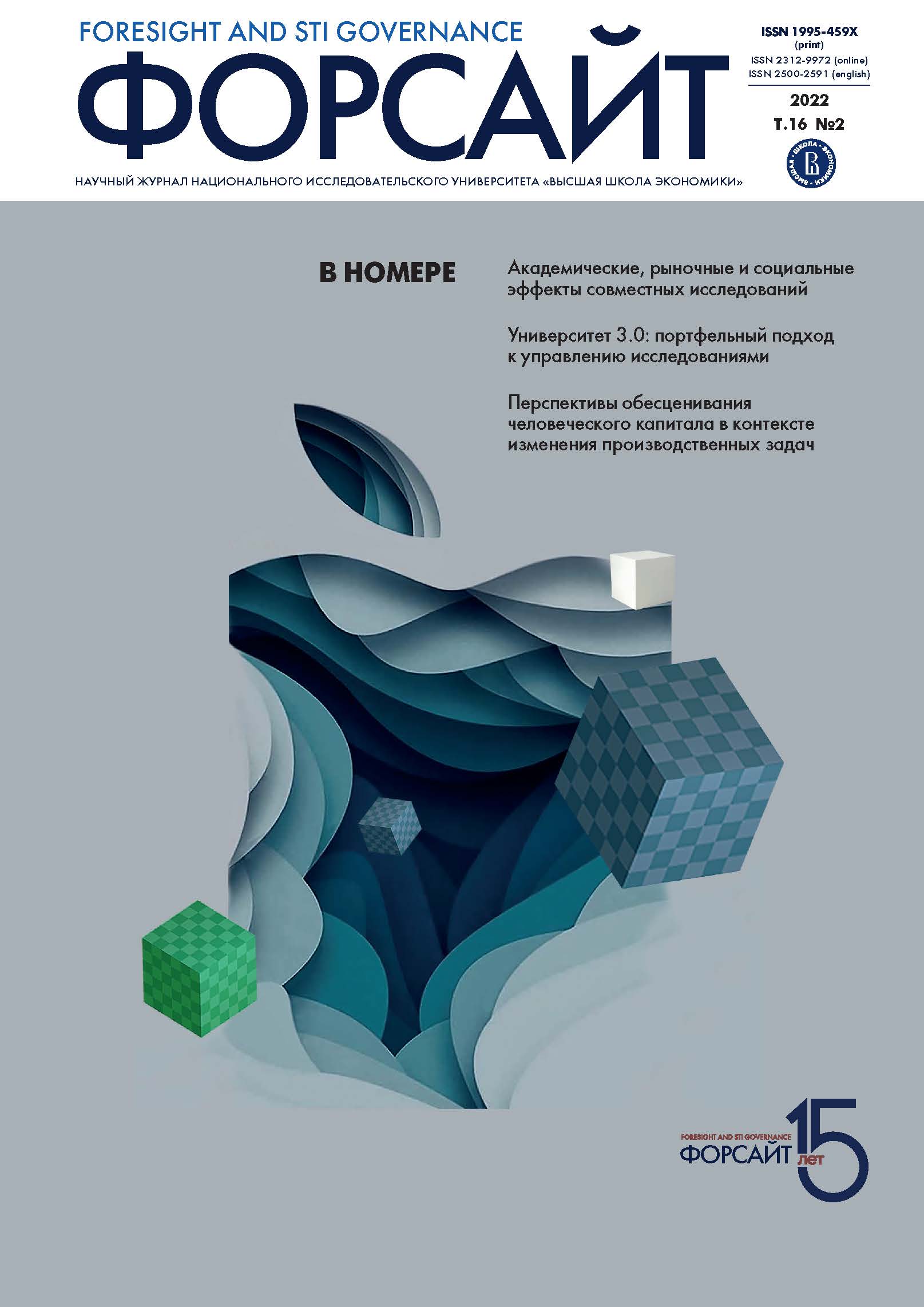Аннотация
Информационные технологии стремительно преобразуют корпоративные принципы управления человеческими ресурсами (УЧР). Эту тенденцию дополнительно усилила пандемия COVID-19, значительно ускорившая темпы распространения цифровых технологий в менеджменте персонала. Компании, способные быстро воспользоваться новыми инструментами УЧР, получают преимущество в сравнении с теми, которые уделяли цифровизации меньше внимания. Вместе с тем, многие факторы и последствия этих процессов и их взаимосвязь с различными параметрами бизнеса остаются плохо изученными. Восполнить пробел позволит анализ ключевых составляющих цифровизации УЧР применительно к значимым характеристикам организаций (размер, структура и текучесть персонала, эффективность деятельности) с использованием данных проведенного нами опроса 449 малых, средних и крупных российских компаний. Полученные результаты позволяют выделить два ключевых компонента цифровизации — количественный и качественный, и если первый связан с охватом, то второй — с эффективностью цифровых практик. Впрочем, сочетание широкого охвата с высокой эффективностью не всегда свидетельствуют об успешности и функциональности компаний.
Литература
Appelbaum E., Bailey T., Berg P., Kallenberg A.L. (2000) Manufacturing advantage: Why high-performance work systems pay off, Ithaca, NY: Cornell University Press.
Bondarouk T., Brewster C. (2016) Conceptualising the future of HRM and technology research. International Journal of Human Resource Management, 27(21), 2652-2671. DOI: https://doi.org/10.1080/09585192.2016.1232296
Bondarouk T., Harms R., Lepak D. (2015) Does e-HRM lead to better HRM service? International Journal of Human Resource Management, 28(9), 1332-1362. DOI: https://doi.org/10.1080/09585192.2015.1118139
Bondarouk T., Parry E., Furtmueller E. (2016) Electronic HRM: Four decades of research on adoption and consequences. International Journal of Human Resource Management, 28(1), 98-131. DOI: https://doi.org/10.1080/09585192.2016.1245672
Bondarouk T.V., Ruël H.J.M. (2009) Electronic human resource management: Challenges in the digital era. International Journal of Human Resource Management, 20, 505-514. DOI: https://doi.org/10.1080/09585190802707235
Bowen D.E., Ostroff C. (2004) Understanding HRM-Firm Performance Linkages: The Role of the Strength of the HRM System. Academy of Management Review, 29(2), 203-221. https://psycnet.apa.org/doi/. DOI: https://doi.org/10.2307/20159029
Brockbank W. (1997) HR's Future on the Way to a Presence. Human Resource Management, 36, 65-69. :1%3C65::AID-HRM11%3E3.0.CO;2-D. DOI: https://doi.org/10.1002/(SICI)1099-050X(199721)36
Fitzgerald M., Kruschwitz N., Bonnet D., Welch M. (2014) Embracing digital technology: A new strategic imperative. MIT Sloan Management Review, 55(2), 1-12. https://sloanreview.mit.edu/projects/embracing-digital-technology/, accessed 15.11.2021.
Fossen F.M., Sorgner A. (2019). Mapping the Future of Occupations: Transformative and Destructive Effects of New Digital Technologies on Jobs. Foresight and STI Governance, 13(2), 10-18. DOI: https://doi.org/10.17323/2500-2597.2019.2.10.18
Gardner T.M., Wright P.M., Moynihan L.M. (2011) The impact of motivation, empowerment, and skill-enhancing practices on aggregate voluntary turnover: The mediating effect of collective affective commitment. Personnel Psychology, 64(2), 315-350. DOI: https://doi.org/10.1111/j.1744-6570.2011.01212.x
Huselid M., Minbaeva D. (2019) Big Data and Human Resource Management. In: The SAGE Handbook of Human Resource Management (eds. A. Wilkinson, N. Bacon, S. Snell, D. Lepak), Thousand Oaks, CA: SAGE Publications Ltd., pp. 494-507. DOI: https://doi.org/10.4135/9781529714852.n29
Kehoe R.R., Collins C.J. (2017) Human Resource Management and Unit Performance in Knowledge-Intensive Work. Journal of Applied Psychology, 102(8), 1222-1236. https://doi.apa.org/doi/. DOI: https://doi.org/10.1037/apl0000216
Kohansal M.A., Sadegh T., Haghshenas M. (2016) E-HRM: From Acceptance to Value Creation. Journal of Information Technology Management, 27(1), 18-27.
Lepak D.P., Snell S.A. (1998) Virtual HR: Strategic human resource management in the 21st century. Human Resource Management Review, 8(3), 215-234. DOI: https://doi.org/10.1016/S1053-4822(98)90003-1
Malik A., Budhwar P., Patel C., Srikanth N.R. (2020) May the bots be with you! Delivering HR cost-effectiveness and individualised employee experiences in an MNE. International Journal of Human Resource Management, Ahead-of-print, 1-31. DOI: https://doi.org/10.1080/09585192.2020.1859582
Njoku E. (2016) An analysis of the contribution of e-HRM to sustaining business performance (doctoral dissertation), Newport: University of South Wales.
Parry E. (2011) An examination of e-HRM as a means to increase the value of the HR function. International Journal of Human Resource Management, 22(5), 1146-1162. DOI: https://doi.org/10.1080/09585192.2011.556791
Parry E., Strohmeier S. (2014) HRM in the digital age - digital changes and challenges of the HR profession. Employee Relations, 36(4). DOI: https://doi.org/10.1108/ER-03-2014-0032
Parry E., Tyson S. (2011) Desired goals and actual outcomes of e-HRM. Human Resource Management Journal, 21(3), 335-354. DOI: https://doi.org/10.1111/j.1748-8583.2010.00149.x
Ruel H., Bondarouk T., Looise J.K. (2004) E-HRM: Innovation or Irritation: An explorative empirical study in five large companies on web-based HRM. Management Revue, 15, 364-381.
Siebert W.S., Zubanov N. (2009) Searching for the optimal level of employee turnover: A study of a large UK retail organization. Academy of Management Journal, 52(2), 294-313. DOI: https://doi.org/10.5465/amj.2009.37308149
Stone D.L., Deadrick D.L., Lukaszewski K.M., Johnson R. (2015) The influence of technology on the future of human resource management. Human Resource Management Review, 25(2), 216-231. DOI: https://doi.org/10.1016/j.hrmr.2015.01.002
Strohmeier S. (2009) Concepts of e-HRM consequences: A categorisation, review and suggestion. International Journal of Human Resource Management, 20, 528-543. DOI: https://doi.org/10.1080/09585190802707292
Strohmeier S. (2020) Digital human resource management: A conceptual clarification. German Journal of Human Resource Management: Zeitschrift für Personalforschung, 34(3), 345-365.
Ulrich D., Dulebohn J. H. (2015) Are we there yet? What's next for HR? Human Resource Management Review, 25(2), 188-204. DOI: https://doi.org/10.1016/j.hrmr.2015.01.004
Vial G. (2019) Understanding digital transformation: A review and a research agenda. The Journal of Strategic Information Systems, 28(2), 118-144. DOI: https://doi.org/10.1016/j.jsis.2019.01.003

Это произведение доступно по лицензии Creative Commons «Attribution» («Атрибуция») 4.0 Всемирная.


